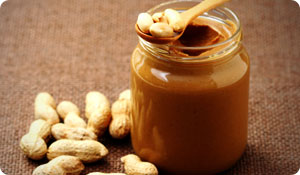
See what people are saying about this article on our Facebook page!![]()
Nuts are good for you, and so are their butters. And they're even better if you make them yourself.
Nuts for Nutrition
No doubt about it, nut butters are high in calories and fat. But in their purest form, they are also packed with the same beneficial nutrients as whole nuts, including protein, fiber, B vitamins, vitamin E, zinc, selenium and other minerals. And the fat in natural nut butters is mostly monounsaturated and polyunsaturated, which are considered the healthiest kinds of fats. When compared, one nut butter provides just about the same nutritional benefits as another. Of the three most common nut butters-peanut, almond and cashew-almonds are a bit lower in saturated, or unhealthy, fats and slightly higher in healthier unsaturated fats. Peanut butter is a bit higher in protein than other nut butters. Individual brands vary in sodium content and types of added ingredients, if any, used in processing.
A Better Butter
As bread spreads go, natural nut butters beat out regular butter, which provides about the same number of calories but is much higher in saturated fats and contains few nutrients other than fat. Although nut butters cannot be used in all the same ways as regular butter, they are probably more versatile than you think. In addition to bread, you can spread them on baby carrots, celery stalks and apple slices. You can stir nut butters into soups and stews, use them in Asian-style sauces for noodles, meats and vegetables, and in salad dressings. For the sake of variety, substitute almond or cashew butter for peanut butter which is more commonly called for as an ingredient in cookies and other baked goods.
Make it Yourself
All you need to make ny kind of nut butter is a food processor and the nut of your choice. Whirl a cup or two of shelled and skinned nuts in the processor for 2 to 4 minutes, depending on the type of nut, or until they form a paste. One cup of nuts makes about 1/2 cup of nut butter. For richer flavor, toast the nuts slightly, for just a few minutes in a 400°oven or in a pan on top of the stove over medium heat. Watch carefully to prevent burning and cool before processing. If your nuts have skins, toasting will make them easier to remove.
What About Allergies?
Obviously, someone who is allergic to peanuts cannot be exposed to peanut butter or any product made from peanuts. A peanut allergy is different from a tree nut allergy, however, because peanuts are actually a type of legume and not technically a nut. Those with nut allergies must avoid nut butters and other products made from cashews, almonds, pecans or any other nuts. Some people are allergic to both peanuts and tree nuts and must avoid all types of nut butter. But then there is soy nut butter, made from soybeans, high in protein and other nutrients, and free from peanuts or tree nuts. A good substitute, unless you have a soy allergy. In that case, you can try a seed butter. Pure sunflower seed butter contains plenty of vitamin E and minerals; no peanuts, no tree nuts, no soy.
See what people are saying about this article on our Facebook page!![]()
Sources:
Mangels, R. "Vegetarian Journal's Guide to Nuts and Nut Butters." Vegetarian Resource Group. Nov/Dec 2001 Web 17 Feb 2010
Pennington Nutrition Series: Soy Isoflavones
http://www.pbrc.edu/division-of-education/pdf/pns/PNS_Soy_Isoflavones.pdf
University of Nebraska Cooperative Extension: Nuts for Nturition Web 17 Feb 2011
http://lancaster.unl.edu/food/ftmar04.htm





